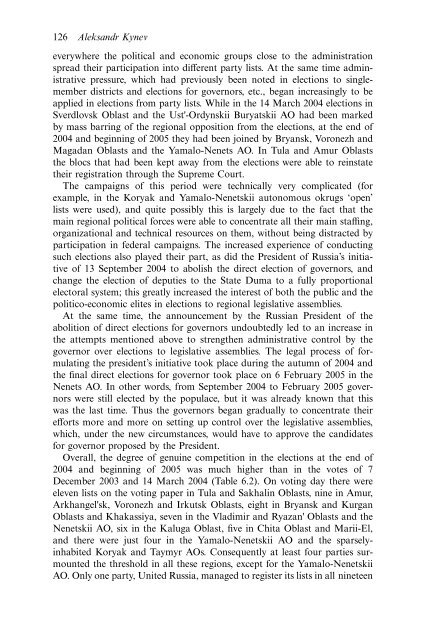Federalism and Local Politics in Russia
Federalism and Local Politics in Russia
Federalism and Local Politics in Russia
Create successful ePaper yourself
Turn your PDF publications into a flip-book with our unique Google optimized e-Paper software.
126 Aleks<strong>and</strong>r Kyneveverywhere the political <strong>and</strong> economic groups close to the adm<strong>in</strong>istrationspread their participation <strong>in</strong>to different party lists. At the same time adm<strong>in</strong>istrativepressure, which had previously been noted <strong>in</strong> elections to s<strong>in</strong>glememberdistricts <strong>and</strong> elections for governors, etc., began <strong>in</strong>creas<strong>in</strong>gly to beapplied <strong>in</strong> elections from party lists. While <strong>in</strong> the 14 March 2004 elections <strong>in</strong>Sverdlovsk Oblast <strong>and</strong> the Ust'-Ordynskii Buryatskii AO had been markedby mass barr<strong>in</strong>g of the regional opposition from the elections, at the end of2004 <strong>and</strong> beg<strong>in</strong>n<strong>in</strong>g of 2005 they had been jo<strong>in</strong>ed by Bryansk, Voronezh <strong>and</strong>Magadan Oblasts <strong>and</strong> the Yamalo-Nenets AO. In Tula <strong>and</strong> Amur Oblaststhe blocs that had been kept away from the elections were able to re<strong>in</strong>statetheir registration through the Supreme Court.The campaigns of this period were technically very complicated (forexample, <strong>in</strong> the Koryak <strong>and</strong> Yamalo-Nenetskii autonomous okrugs ‘open’lists were used), <strong>and</strong> quite possibly this is largely due to the fact that thema<strong>in</strong> regional political forces were able to concentrate all their ma<strong>in</strong> staff<strong>in</strong>g,organizational <strong>and</strong> technical resources on them, without be<strong>in</strong>g distracted byparticipation <strong>in</strong> federal campaigns. The <strong>in</strong>creased experience of conduct<strong>in</strong>gsuch elections also played their part, as did the President of <strong>Russia</strong>’s <strong>in</strong>itiativeof 13 September 2004 to abolish the direct election of governors, <strong>and</strong>change the election of deputies to the State Duma to a fully proportionalelectoral system; this greatly <strong>in</strong>creased the <strong>in</strong>terest of both the public <strong>and</strong> thepolitico-economic elites <strong>in</strong> elections to regional legislative assemblies.At the same time, the announcement by the <strong>Russia</strong>n President of theabolition of direct elections for governors undoubtedly led to an <strong>in</strong>crease <strong>in</strong>the attempts mentioned above to strengthen adm<strong>in</strong>istrative control by thegovernor over elections to legislative assemblies. The legal process of formulat<strong>in</strong>gthe president’s <strong>in</strong>itiative took place dur<strong>in</strong>g the autumn of 2004 <strong>and</strong>the f<strong>in</strong>al direct elections for governor took place on 6 February 2005 <strong>in</strong> theNenets AO. In other words, from September 2004 to February 2005 governorswere still elected by the populace, but it was already known that thiswas the last time. Thus the governors began gradually to concentrate theirefforts more <strong>and</strong> more on sett<strong>in</strong>g up control over the legislative assemblies,which, under the new circumstances, would have to approve the c<strong>and</strong>idatesfor governor proposed by the President.Overall, the degree of genu<strong>in</strong>e competition <strong>in</strong> the elections at the end of2004 <strong>and</strong> beg<strong>in</strong>n<strong>in</strong>g of 2005 was much higher than <strong>in</strong> the votes of 7December 2003 <strong>and</strong> 14 March 2004 (Table 6.2). On vot<strong>in</strong>g day there wereeleven lists on the vot<strong>in</strong>g paper <strong>in</strong> Tula <strong>and</strong> Sakhal<strong>in</strong> Oblasts, n<strong>in</strong>e <strong>in</strong> Amur,Arkhangel'sk, Voronezh <strong>and</strong> Irkutsk Oblasts, eight <strong>in</strong> Bryansk <strong>and</strong> KurganOblasts <strong>and</strong> Khakassiya, seven <strong>in</strong> the Vladimir <strong>and</strong> Ryazan' Oblasts <strong>and</strong> theNenetskii AO, six <strong>in</strong> the Kaluga Oblast, five <strong>in</strong> Chita Oblast <strong>and</strong> Marii-El,<strong>and</strong> there were just four <strong>in</strong> the Yamalo-Nenetskii AO <strong>and</strong> the sparsely<strong>in</strong>habitedKoryak <strong>and</strong> Taymyr AOs. Consequently at least four parties surmountedthe threshold <strong>in</strong> all these regions, except for the Yamalo-NenetskiiAO. Only one party, United <strong>Russia</strong>, managed to register its lists <strong>in</strong> all n<strong>in</strong>eteen
















